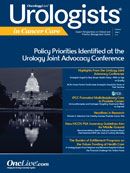Publication
Article
Oncology Live Urologists in Cancer Care®
Immediate Surgery Improves Outcomes in Localized Prostate Cancer
Author(s):
A recent study that followed men newly diagnosed with localized prostate cancer for a median 18 years found that immediate radical prostatectomy significantly cut death rates as compared with watchful waiting with treatment upon progression, especially in men with intermediate-risk disease.
A recent study that followed men newly diagnosed with localized prostate cancer for a median 18 years found that immediate radical prostatectomy significantly cut death rates as compared with watchful waiting with treatment upon progression, especially in men with intermediate-risk disease.
The strategy also reduced the chance that men would need therapies to treat metastasis later in life.
The study, known as the Scandinavian Prostate Cancer Group Study Number 4 (SPCG-4), was conducted in Sweden, Finland, and Iceland, and its results are an update—with further stratification based on age, tumor risk, and long-term disease burden—to findings published after 15 years of follow-up.
While the study provided insights into the natural history of prostate cancer, it was also meant to add evidence to the debate about active surveillance, but because the trial was launched before screening for prostate-specific antigen (PSA) was routinely used to help track the severity of prostate cancer, its results must be considered in that light, authors Bill-Axelson et al cautioned. Disease in study participants was more advanced than in typical newly diagnosed patients today, with 88% having palpable tumors, and risk categorization in the study was less sophisticated than that available now.
“Given these caveats, the small absolute risk reduction in the rate of death from prostate cancer in the low-risk group at 18 years does not contradict current guidelines recommending active surveillance in men with low-risk prostate cancer,” the authors wrote.
They added that, “Although the disease burden was large in the watchful-waiting group, a substantial proportion of men in this group did not have disease progression and did not receive palliative treatment. Therefore, there is a need to identify markers of aggressive disease.”
For the study, between October 1989 and December 1999, investigators randomized 695 men with localized prostate cancer 1:1 to either radical prostatectomy or watchful waiting. The men were under age 75 years with life expectancies of more than 10 years, low-grade tumors, no bone lesions, and PSAs <50 ng/mL.
=.001). As more time passed, men who underwent surgery experienced a growing reduction in their rate of death, the authors wrote.
Men in the watchful waiting group had a higher rate of metastasis (38.3% vs 26.1%), leaving the surgery group with a relative risk of distant metastasis of 0.57 (P <.001).
At 18 years, 60% of the watchful waiting cohort and 40% of the surgery cohort had experienced disease progression and been treated with androgen deprivation therapy or other palliative treatments. Both metastasis and treatment with androgen deprivation therapy are strongly associated with a reduced quality of life, the authors wrote.
They also noted, however, that men in the surgical group had significantly more urinary leakage (41% vs 11%) at 12.4 years. Men under age 65 years in the surgical group demonstrated reductions of 25.5% in overall mortality, 15.8% in prostate cancer death, and 15.8% in the risk of metastasis, while men over 65 years in the surgical group experienced a non-significant trend toward reduced mortality and an 8.9% reduction in metastases compared with their nonsurgical counterparts, the authors wrote.
As far as disease severity, men with intermediate-risk tumors experienced the greatest advantage from surgery, with a reduction of 15.5% in overall mortality, 24.2% in the rate of death from prostate cancer, and 19.9% in the risk of metastases (P=.07).
By the end of 2012, the cumulative incidence of death at 18 years from prostate cancer was 17.7% in the prostatectomy group versus 28.7% in the watchful waiting group, resulting in a relative risk of death in the surgery group of 0.56 (
Reference
Bill-Axelson A, Holmberg L, Garmo H, et al. Radical prostatectomy or watchful waiting in early prostate cancer. N Engl J Med. 2014;370:932-942.










